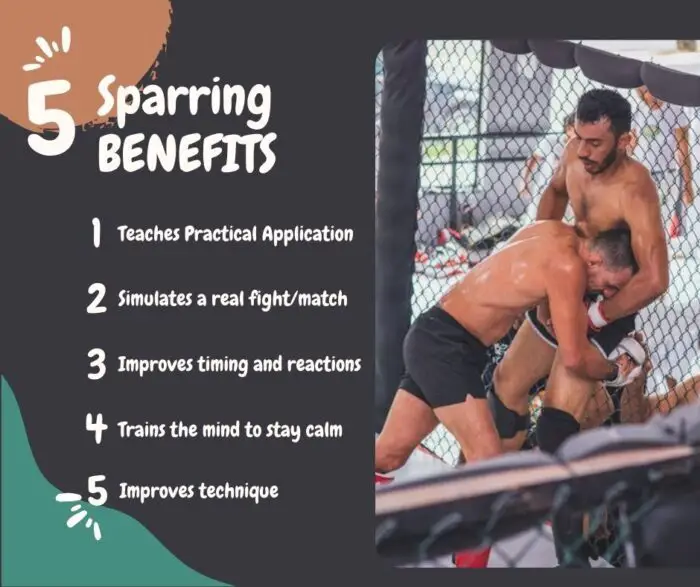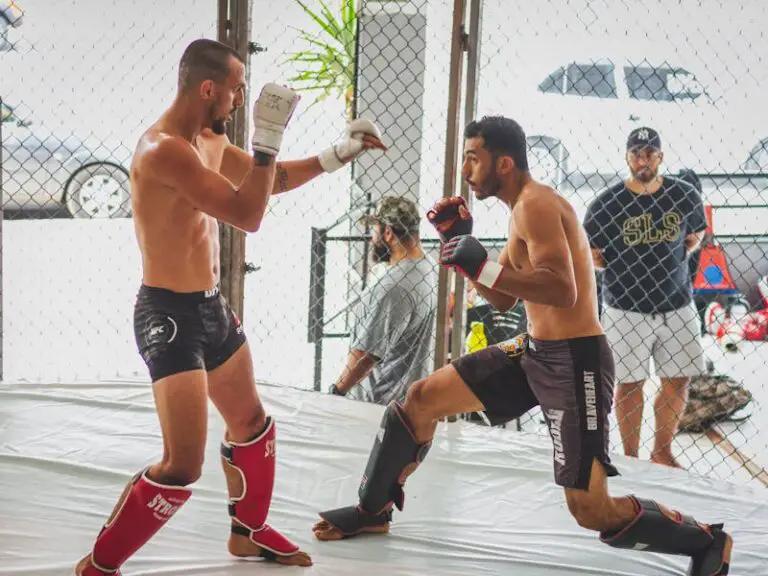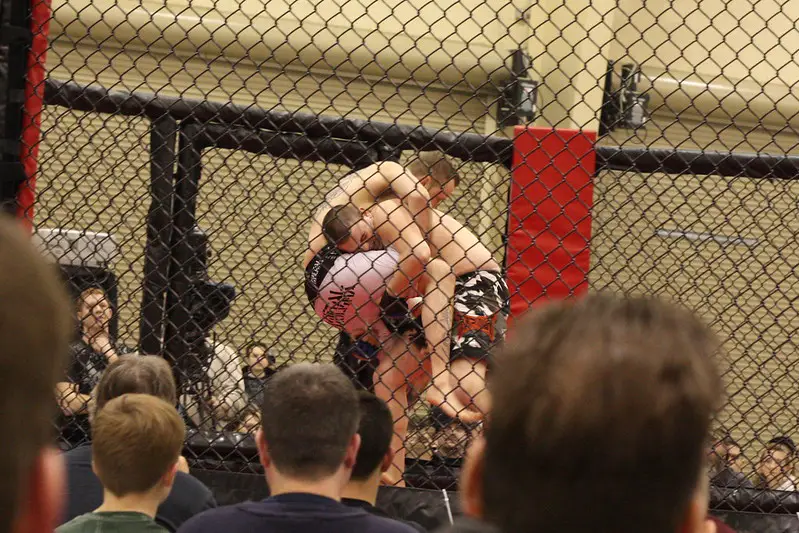MMA sparring is a key component of MMA training. It is a method used to teach practitioners how to apply skills in a real match but in a controlled environment. However, many beginners wonder how dangerous is sparring, and what are the risks of injuries.
So in this article, we are bringing you a detailed explanation of MMA sparring, how safe it is, and what you can do to minimize the risks. Also, we will provide you with some great tips on how to get the most out of these sessions.
Is MMA Sparring Dangerous?
Sparring is safe when you do it the right way and most injuries happen by accident. This part of training involves physical contact, often intense, and as such, it carries a certain risk of injuries. But when done the right way, it is not more dangerous than other sports that involve physical contact such as football or soccer.
While MMA competition is dangerous, training is safe for the most part for the following reasons.
All participants must wear protective gear
Whether it is striking, grappling, or MMA sparring, all practitioners must wear protective gear, notably beginners. The gear includes a head guard, shin pads, mouth and groin guard, and padded gloves. Wearing the gear absorbs most of the impact and decreases the risk of minor or severe injuries.
The only exception is when pro fighters train for matches. To simulate a real match, they would do a couple of sessions without the gear. However, this is a rare exception. Students in the learning stage all wear the gear.
Emphasis on light contact and technique
Sparring is not a real fight. It aims to simulate how the match looks like in a controlled environment. It enables practitioners to practice and improve techniques under supervision and in a safe environment.
Thus, the emphasis is on light contact and technique over sheer power. Beginners start by sparring using 30–50% of power. Even senior practitioners rarely go above that.
In combination with proper gear, light contact significantly reduces the risk of injuries and makes MMA sparring safe.
Strict Gym Rules
Most MMA academies embrace respect and sportsmanship. When it comes to sparring, there is no bullying, taunting, or aggressive behaviour. All practitioners must control their emotions and do their best to keep both parties safe. In most gyms, students who break these rules first receive a warning before getting kicked out.
Most injuries happen by accident
The majority of training injuries happen by accident. Beginners are yet to learn how to strike with proper form or fall down to the ground. Landing a punch or kick at the wrong angle or falling down directly on the shoulder can easily result in an injury. These are usually muscle strains, dislocations, bruises, etc.
MMA Beginners Sparring Tips
The first MMA sparring session is both fun and scary for most beginners and this is normal. Be sure to wear all the protective gear, try your best to stay focused on technique and light contact, and control your emotions. This is your main task.
No one is expecting you to be good. Do not be ashamed if you fail or get overwhelmed by a more skilled practitioner. It is your first sparring session so coaches are well aware of your abilities. They only want you to be focused, maintain composure, and spar safely. In some way, they want confirmation that you are ready to start sparring regularly.
Being scared and confused is normal. Most beginners feel a certain dose of fear of sparring. This is good. Fear in a healthy dose is your ally. It’s normal to be scared in the first sparring session and look lost and confused. You will probably have a hard time breathing and gass out too. That’s fine.
Fear and learning how to control emotions come with experience. it’s one of those things that separate beginners from skilled practitioners.
Embrace the moment and be proud of yourself. You stepped out of your comfort zone and successfully challenged yourself. Realize this is just the start of a new chapter, and embrace all the challenges that come in the future.
How to Spar Safely? (Sparring Etiquette)
Safely sparring in MMA requires a combination of preparation, technique, and communication between training partners. Here are some tips to spar safely in MMA:
- Warm-up – Always begin with a proper warm-up to prepare your body for the intensity of sparring. This can include jogging, dynamic stretching, and specific movements to engage the muscles you’ll be using.
- Use Protective Gear – Wear appropriate protective gear such as mouthguards, groin protectors, MMA gloves, shin guards, and headgear if necessary. This helps to minimize the risk of injuries.
- Know Your Partner – Spar with someone who is at a similar skill level and understands the importance of safety. Communicate with your partner about your intentions, limits, and any injuries you may have.
- Controlled Intensity – Start sparring at a lower intensity, especially if you’re new to it or warming up. Gradually increase the intensity as both you and your partner feel comfortable. Avoid going full force during training sessions.
- Focus on Technique – Emphasize technique over power. Focus on proper form and execution of techniques rather than trying to overpower your opponent. This reduces the risk of injuries and helps improve your skills.
- Stay Relaxed – Tension increases the risk of injury. Stay relaxed and fluid in your movements to minimize strain on your muscles and joints.
- Communicate – Constantly communicate with your partner during sparring. If something doesn’t feel right or if you need to stop, communicate it immediately. Mutual respect and understanding are key to safe sparring.
- Tap Out – Establish a signal, such as tapping the mat or your partner, to indicate when you want to stop or if you’re in a vulnerable position. Always respect your partner’s tap and stop immediately.
MMA Sparring Tips For Faster Progress
The key to learning MMA faster is to focus on consistency, mastering the basics first, and improving defense and footwork. Also, communicate with the coaches, be open to constructive feedback, and trust the process.
- Mastering the basics is important because you need a good base on top of which you can add more complex moves. Many practitioners want to fast-track their progress by skipping levels, but this never works. It results in bad habits that are later hard to correct.
- Embrace the struggles — it’s going to be hard and exhausting. You are going to eat many humble pies, but that’s a part of learning. Trust the process and your time will come.
- Footwork and movement — are hard to learn. Thus, switch your focus on this segment right from the start and it will pay off in the long run. It helps you judge distance, avoid damage, and create offensive and defensive opportunities.
- Work on Defense — practice blocking, parrying, and evasive manoeuvres. Due to the comfort that comes with sparring, many students neglect defense for some reason. But that’s not going to be you.
- Stay relaxed — Relaxation is key to fluid movement and faster reaction times. Tension can slow you down and hinder your ability to think on your feet. Stay loose and calm during sparring sessions.
- Listen to your coaches and partners — they can provide valuable insights, correct mistakes, and offer personalized advice to help you progress faster.
What Are The Benefits of MMA Sparring?
Sparring teaches practitioners how to apply skills in a real match or fight. It prepares them for both the physical and mental demands of an unpredictable and intense combat scenario. This includes training their reactions, timing, coordination, muscle memory, and mind.

Here is a more detailed explanation of why MMA sparring is an essential part of learning:
- Improves technique
Performing on the heavy bag and in live action is not the same. Thus, sparring elevates your skills to an extra level by teaching you how to use it against a fully resisting opponent. This includes fine-tuning your form to the slightest detail and developing your signature style.
- Improves timing and reactions
MMA beginners can’t expect to develop timing and reactions without sparring. You need a moving target who is resisting to learn how to time your grappling or striking attacks. The same stands for reactions when someone is attacking you.
- Teaches you how to stay calm
Real combat is mentally intense and forces your mind into fight or flight mode. But MMA sparring trains your mind to control your emotions and stay calm. In the long run, you will learn how to breathe, keep the adrenaline and fear low, and focus on the task ahead.
A clear mind is the only way you can have enough awareness to make rational decisions.
- Enables you to simulate a real match
In the end, MMA sparring is important as it enables you to simulate a real match in a controlled and safe environment. The key is to do as many simulations until fighting becomes second nature.
Can You Learn MMA Without Sparring?
While sparring plays a key role in learning MMA, it is possible to gain some skills without it. However, you won’t be able to develop vital skills to compete in matches or improve your self-defense abilities.
Here are some aspects of MMA that you can focus on without sparring:
- Technique Training — you can learn and practice various striking and grappling techniques without engaging in live sparring. Shadowboxing, drilling with a partner, and working on techniques with focus mitts or pads are all valuable ways to develop your skills.
- Conditioning — building your strength, endurance, and flexibility is a crucial aspect of MMA training. This can be done through various exercises, such as weight training, cardiovascular workouts, and agility drills.
- Bag Work — training with heavy bags, speed bags, and double-end bags can help you improve your striking power, accuracy, and timing. This allows you to work on your striking skills without the need for a sparring partner.
- Technical Drills — practice specific techniques and combinations with a partner in a controlled environment. This can involve light contact and emphasizes technical precision rather than full-force sparring.
However, it’s crucial to note that live sparring is the best method for preparing for actual competition. First, it helps you adapt to the unpredictable nature of a fight. It also improves your timing and enhances your ability to implement techniques under pressure.
How To Overcome The Fear of Sparring?
Final Thoughts On Beginners Sparring in MMA
MMA sparring is fun, playful, and safe if you approach it the right way. It is a training method that aims to bridge the gap between technical training and real fighting. Thus, it is essential in terms of skill development.
However, be sure to approach it with an open mind to minimize the risks. First, train in a legitimate school that prioritizes safety. Next, always wear protective gear and focus on technique and light contact rather than sheer power. Do your best to control emotions and avoid getting into brawls.
In the end, MMA sparring is a part of the learning process. It is not a fight or official match where you must perform at your best to win. No, it enables you to make mistakes and improve, and of course, have a lot of fun.


